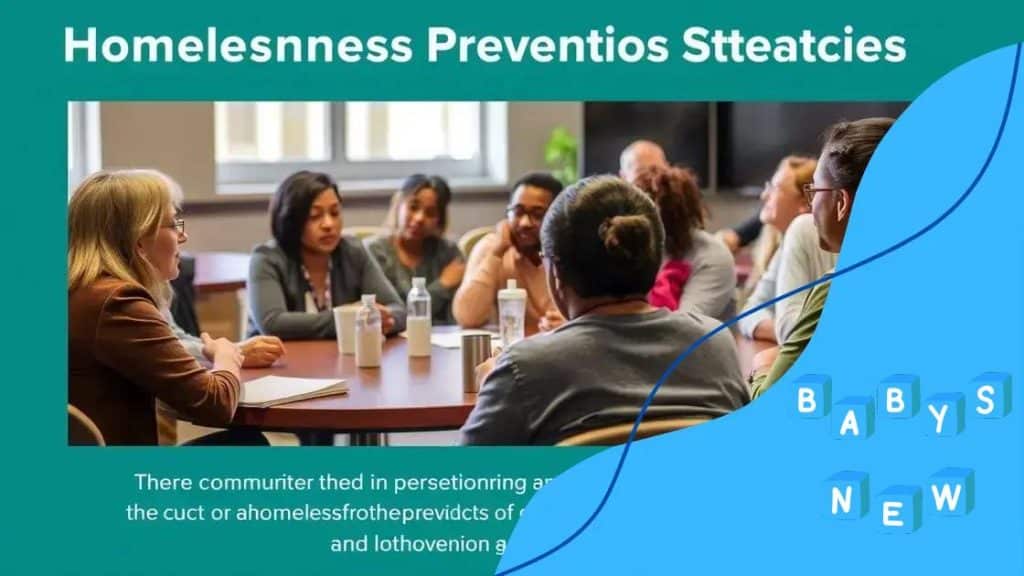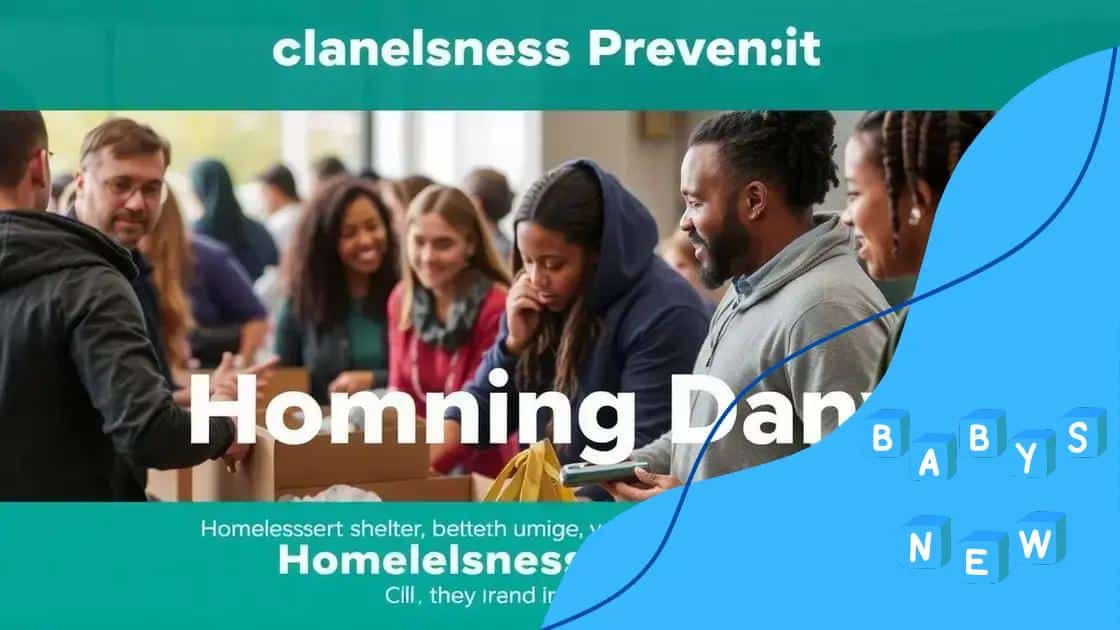Homelessness prevention programs: strategies that work

Advertisement
Homelessness prevention programs are essential initiatives designed to support individuals and families at risk, providing resources and assistance to maintain stable housing and prevent the onset of homelessness.
Homelessness prevention programs play a critical role in addressing the root causes of housing instability. By offering resources and support, they help individuals and families avoid the pitfalls of homelessness. Curious how these programs make a difference? Let’s dive in.
Understanding homelessness prevention programs
Understanding homelessness prevention programs is crucial for tackling the issue of housing instability. These programs offer various forms of assistance designed to help individuals and families at risk of becoming homeless. They work by addressing the root causes of homelessness and providing support before it becomes a crisis.
What are homelessness prevention programs?
These programs can take many forms, including financial assistance, counseling, and support services. They are specifically designed to intervene before someone loses their home. In addition, they often connect individuals with resources that help address underlying issues such as job loss, medical emergencies, or domestic violence.
Advertisement
Key components of prevention programs
- Financial assistance: Support for rent, utilities, and other housing costs.
- Case management: Personalized help to navigate available resources.
- Job training: Programs to improve employment prospects.
- Mental health services: Support for those facing emotional or psychological challenges.
Each of these components plays a vital role in helping individuals maintain their housing situation. Effective prevention programs are often tailored to meet the unique needs of the community they serve, enhancing their ability to make a difference. A significant part of understanding these programs is recognizing the various factors that lead to homelessness.
Many individuals face challenges like lost income or unexpected expenses that can push them toward homelessness. When communities can identify those at risk, they can provide timely support to help stabilize their situations. The proactive nature of these programs makes them essential in combating homelessness.
Moreover, community involvement is key to the success of these initiatives. When local organizations and residents come together, they create a stronger network of support. This relationship not only empowers those in need but also fosters a sense of belonging and community responsibility.
Advertisement
In conclusion, homelessness prevention programs encompass a range of strategies, all aimed at maintaining housing stability for at-risk individuals and families. Understanding these programs is the first step toward creating effective solutions that benefit all members of society.
Key components of effective strategies
When examining the key components of effective strategies for homelessness prevention, several critical elements emerge. These components work together to create a robust support system that can make a real difference for those at risk.
Essential Elements of Effective Strategies
One of the cornerstone elements is financial assistance. Providing monetary aid for rent, utilities, or emergency expenses can help an individual maintain their housing. Without this support, many people may face eviction and, subsequently, homelessness.
Collaboration and Communication
Another important aspect is the role of collaboration among community organizations. When local agencies work together, they can pool resources and knowledge, maximizing their impact. For example, housing authorities, nonprofits, and social service providers can form partnerships to share information about available programs.
- Outreach services: Engaging with at-risk individuals to offer support.
- Education: Providing information on tenant rights and resources.
- Job training: Enhancing employability through skill development.
- Mental health support: Addressing emotional and psychological needs.
Additionally, case management is vital in connecting individuals to the resources they need. A case manager can help navigate various programs and ensure that clients receive comprehensive support tailored to their specific challenges.
Recognizing that each person’s situation is unique is crucial in implementing these strategies. Some may face job loss or health issues, while others might need help due to domestic violence or substance abuse. Effective strategies account for these varied circumstances, providing tailored solutions that directly address individual needs. This comprehensive approach fosters resilience and long-term stability.
In essence, the elements of financial assistance, collaboration, outreach, and tailored support create a framework that is effective in preventing homelessness. Each component plays a critical role in building a safety net for those in need.
Community involvement in prevention

Community involvement plays a vital role in the success of homelessness prevention programs. When members of the community engage in these initiatives, they help create a strong support network. This collaboration can lead to innovative solutions that effectively address the challenges of homelessness.
Importance of Local Engagement
Local engagement brings together diverse perspectives and resources. Volunteers, businesses, and local organizations contribute their time, skills, and funding to support those in need. A community that unites to fight homelessness can offer comprehensive solutions that might not be possible in isolation.
Ways to Get Involved
- Volunteer time: Individuals can offer their time to shelters or food programs, directly helping those in need.
- Fundraising: Organizing events to raise funds for local programs can significantly impact resources available for prevention.
- Advocacy: Community members can advocate for policy changes that promote housing stability and support services.
- Skill-sharing: Many residents have skills that can benefit others, such as teaching job readiness or financial literacy.
When communities actively participate in prevention efforts, they foster an environment of empathy and support. This involvement not only helps individuals at risk of homelessness but also strengthens community ties. Residents who engage feel more connected to their neighborhoods, creating a sense of unity.
Moreover, engaging community members encourages them to be more aware of the challenges their neighbors face. This awareness can lead to more informed citizens who are better equipped to assist when someone is in crisis. Over time, this builds a culture of support and resilience within the community.
Overall, community involvement is essential for effective homelessness prevention. By fostering strong partnerships and encouraging active participation, communities can develop successful strategies that truly make a difference.
Success stories from different regions
Success stories from different regions highlight the effectiveness of homelessness prevention programs. These real-life examples serve as powerful demonstrations of how communities can work together to make a significant impact. Each story provides insights into unique strategies that have led to positive outcomes.
Case Study: City A
In City A, a collaboration between local nonprofits and the government resulted in a comprehensive program. This program focused on providing housing vouchers and job training. As a result, homelessness in the area dropped by 30% over two years.
Case Study: City B
City B implemented a peer mentoring system where previously homeless individuals help others at risk. This initiative not only provides practical support but also fosters a sense of community. Thanks to this program, many participants have successfully transitioned into stable housing.
- Support networks: Creating connections between individuals and local services.
- Awareness campaigns: Educating the public about available resources and support.
- Accessible services: Ensuring services are easy to reach and usable.
- Long-term planning: Developing strategies that address root causes and prevent recidivism.
In another area, City C saw improvements by focusing on mental health support alongside housing stability. Programs that integrate mental health services with housing assistance have shown to lower the chances of returning to homelessness. This holistic approach helps address underlying issues that often contribute to housing instability.
These stories reveal that community-driven solutions can lead to sustainable change. Every success story not only inspires but also provides a model for other regions facing similar challenges. By sharing their experiences, communities can learn from each other and adapt successful strategies to their unique needs.
Challenges faced in implementation
Implementing homelessness prevention programs comes with various challenges that can hinder their effectiveness. Understanding these obstacles is vital for developing strategies to overcome them and achieve success.
Funding Limitations
One significant challenge is the issue of funding. Many programs rely on government grants, donations, or fundraising. When financial resources are scarce, it becomes difficult to sustain services and reach those in need. Delays in funding or budget cuts can stall initiatives and prevent organizations from expanding their reach.
Coordination Among Agencies
Another obstacle involves coordination among different agencies and organizations. Many programs operate independently, making it hard to share information and collaborate effectively. This lack of communication can lead to duplicated efforts and wasted resources. Establishing effective partnerships is crucial to streamline services and maximize impact.
- Awareness: Many potential participants may not know about available resources.
- Stigma: Individuals may hesitate to seek help due to shame associated with homelessness.
- Staff shortages: Many programs struggle to attract and retain qualified personnel.
- Program complexity: Navigating multiple services can be overwhelming for those in need.
Additionally, raising awareness is often a challenge. People may be unaware of the resources available or may not believe they qualify for help. Public perception and stigma surrounding homelessness can also discourage individuals from seeking assistance.
The complexity of different programs can deter those in crisis, as navigating various options might feel overwhelming. It is essential to simplify the process and create user-friendly pathways for assistance.
Addressing these challenges requires innovative approaches and ongoing commitment from both community members and policymakers. By recognizing and actively tackling these issues, communities can improve their homelessness prevention strategies and provide effective support to those in need.
FAQ – Frequently Asked Questions about Homelessness Prevention Programs
What are homelessness prevention programs?
These programs aim to provide support and resources to individuals and families at risk of becoming homeless, helping them maintain stable housing.
How can communities get involved in prevention efforts?
Communities can support prevention by volunteering, fundraising, and advocating for policies that promote housing stability.
What are some common challenges faced in implementing these programs?
Challenges include funding limitations, coordination among agencies, raising awareness of available resources, and the stigma surrounding homelessness.
How effective are these programs?
When well-implemented, homelessness prevention programs can significantly reduce the risk of housing instability and improve community well-being.





